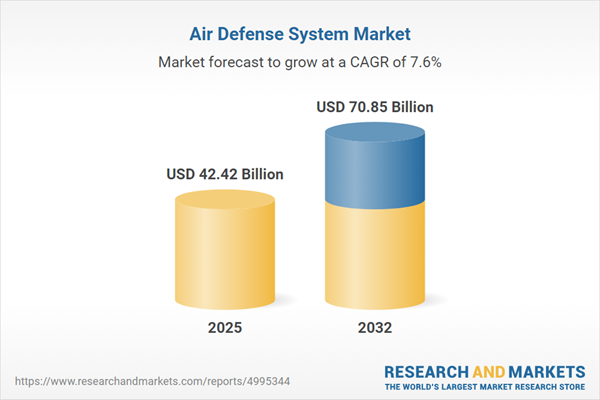Speak directly to the analyst to clarify any post sales queries you may have.
The air defense system market is undergoing significant transformation as modern threats become more complex and organizations seek integrated, responsive defense solutions. Senior decision-makers require actionable intelligence to support effective procurement, technology investment, and operational planning in this dynamic sector.
Market Snapshot: Air Defense System Market Size and Growth
The air defense system market is demonstrating rapid growth, with strong investment momentum from USD 39.48 billion to USD 42.42 billion between 2024 and 2025. Projections indicate expansion to USD 70.85 billion by 2032, reflecting a compound annual growth rate (CAGR) of 7.58%. This trajectory is fueled by increasing demand for multi-layered defense, the acceleration of system upgrades, and swift deployment of advanced command and detection technologies. Enhanced radar, sensor integration, and innovative command infrastructure are boosting operational awareness and response times. The growing focus on interoperability ensures defense stakeholders can evaluate threats quicker, coordinate missions efficiently, and maintain high readiness across domains.
Scope & Segmentation of the Air Defense System Market
This report delivers an in-depth segmentation framework, providing a comprehensive basis for investment and modernization decisions aligned with current operational demands and regional dynamics. Key segments addressed include:
- Platform Types: Multi-domain solutions encompassing airborne, land, and naval platforms enable tailored defenses suited to varying threat environments and mission needs.
- Service Offerings: Broad service coverage includes ongoing maintenance, streamlined delivery, and immersive operator training, such as simulation-based and real-world readiness exercises.
- Component Categories: Integration focuses on sophisticated command modules, advanced radar systems, updated missile launch capabilities, and electro-optical technologies like thermal imaging and laser ranging.
- Application Areas: Systems address broad coverage, asset-specific shielding, network-linked security, and protection of critical infrastructure in complex situations.
- End Users: Solutions serve military branches—air, land, and maritime—along with agencies managing borders and regional security operations through scalable infrastructure.
- Regional Focus: Insights span the Americas, Europe, Middle East, Africa, and Asia-Pacific, with attention to procurement trends, compliance frameworks, and unique regional requirements shaping deployment strategies.
- Key Players Reviewed: The analysis profiles key contributors such as Lockheed Martin, Raytheon Technologies, Northrop Grumman, Thales, BAE Systems, MBDA, Bharat Electronics, Leonardo, Israel Aerospace Industries, and Saab, highlighting their technological impact and market presence.
This segmentation equips leaders to prioritize procurement initiatives, pursue strategic alliances, and pace programs to match technological, operational, and regulatory development.
Key Takeaways for Senior Decision-Makers
- Modular and integrated defense architectures enable adaptation to evolving aerial threats and enhance operational flexibility.
- Cutting-edge radar and analytics tools, including artificial intelligence, allow organizations to advance real-time detection and situational mastery.
- Collaboration with research institutions accelerates the adoption of customized solutions for increasingly diverse mission scenarios.
- Emphasizing system compatibility boosts cohesion across allied and partner operations, strengthening multi-force readiness.
- Resilient and diversified supply chains minimize operational risk from shifts in procurement or logistics instability.
- Sustained training—blending simulation with live practice—ensures forces keep pace with new technologies and mission complexities.
Tariff Impact and Supply Chain Considerations
Adjustments in U.S. tariff policy have led manufacturers to rethink sourcing, evolving supply strategies to foster reliable supplier ties within friendly markets. Expanding regional networks supports organizations in addressing disruptions tied to trade policy or global supply challenges. Diversification of sourcing enhances reliability and operational flexibility for defense agencies.
Methodology & Data Sources
The report’s findings derive from structured executive interviews, in-depth reviews of leading industry publications, and analysis of reputable government datasets. Contributions from subject-matter analysts ensure that the data delivers actionable guidance for modern defense requirements.
Why This Report Matters
- Enables informed procurement and investment aligned to anticipated trends and advancements in the air defense system market.
- Offers guidance to mitigate risk by outlining shifts in regulatory landscapes and technology innovation impacting global operations.
- Supports agile decision-making by integrating technology leadership and regional insights for a competitive strategic edge.
Conclusion
This report delivers senior executives the insights needed for agile procurement, technological adaptation, and the development of resilient air defense capabilities to meet present and future operational demands.
Additional Product Information:
- Purchase of this report includes 1 year online access with quarterly updates.
- This report can be updated on request. Please contact our Customer Experience team using the Ask a Question widget on our website.
Table of Contents
3. Executive Summary
4. Market Overview
7. Cumulative Impact of Artificial Intelligence 2025
Companies Mentioned
The companies profiled in this Air Defense System market report include:- Lockheed Martin Corporation
- Raytheon Technologies Corporation
- Northrop Grumman Corporation
- Thales S.A.
- BAE Systems plc
- MBDA S.A.
- Bharat Electronics Limited
- Leonardo S.p.A.
- Israel Aerospace Industries Ltd.
- Saab AB
Table Information
| Report Attribute | Details |
|---|---|
| No. of Pages | 193 |
| Published | October 2025 |
| Forecast Period | 2025 - 2032 |
| Estimated Market Value ( USD | $ 42.42 Billion |
| Forecasted Market Value ( USD | $ 70.85 Billion |
| Compound Annual Growth Rate | 7.5% |
| Regions Covered | Global |
| No. of Companies Mentioned | 11 |









